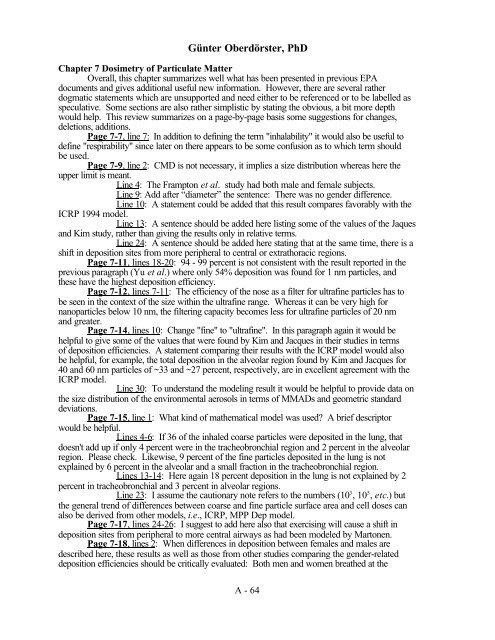Review of the Air Quality Criteria Document for Particulate Matter
Review of the Air Quality Criteria Document for Particulate Matter
Review of the Air Quality Criteria Document for Particulate Matter
- No tags were found...
You also want an ePaper? Increase the reach of your titles
YUMPU automatically turns print PDFs into web optimized ePapers that Google loves.
Günter Oberdörster, PhDChapter 7 Dosimetry <strong>of</strong> <strong>Particulate</strong> <strong>Matter</strong>Overall, this chapter summarizes well what has been presented in previous EPAdocuments and gives additional useful new in<strong>for</strong>mation. However, <strong>the</strong>re are several ra<strong>the</strong>rdogmatic statements which are unsupported and need ei<strong>the</strong>r to be referenced or to be labelled asspeculative. Some sections are also ra<strong>the</strong>r simplistic by stating <strong>the</strong> obvious, a bit more depthwould help. This review summarizes on a page-by-page basis some suggestions <strong>for</strong> changes,deletions, additions.Page 7-7, line 7: In addition to defining <strong>the</strong> term "inhalability" it would also be useful todefine "respirability" since later on <strong>the</strong>re appears to be some confusion as to which term shouldbe usedṖage 7-9, line 2: CMD is not necessary, it implies a size distribution whereas here <strong>the</strong>upper limit is meant.Line 4: The Frampton et al. study had both male and female subjects.Line 9: Add after “diameter” <strong>the</strong> sentence: There was no gender difference.Line 10: A statement could be added that this result compares favorably with <strong>the</strong>ICRP 1994 model.Line 13: A sentence should be added here listing some <strong>of</strong> <strong>the</strong> values <strong>of</strong> <strong>the</strong> Jaquesand Kim study, ra<strong>the</strong>r than giving <strong>the</strong> results only in relative terms.Line 24: A sentence should be added here stating that at <strong>the</strong> same time, <strong>the</strong>re is ashift in deposition sites from more peripheral to central or extrathoracic regions.Page 7-11, lines 18-20: 94 - 99 percent is not consistent with <strong>the</strong> result reported in <strong>the</strong>previous paragraph (Yu et al.) where only 54% deposition was found <strong>for</strong> 1 nm particles, and<strong>the</strong>se have <strong>the</strong> highest deposition efficiency.Page 7-12, lines 7-11: The efficiency <strong>of</strong> <strong>the</strong> nose as a filter <strong>for</strong> ultrafine particles has tobe seen in <strong>the</strong> context <strong>of</strong> <strong>the</strong> size within <strong>the</strong> ultrafine range. Whereas it can be very high <strong>for</strong>nanoparticles below 10 nm, <strong>the</strong> filtering capacity becomes less <strong>for</strong> ultrafine particles <strong>of</strong> 20 nmand greater.Page 7-14, lines 10: Change "fine" to "ultrafine". In this paragraph again it would behelpful to give some <strong>of</strong> <strong>the</strong> values that were found by Kim and Jacques in <strong>the</strong>ir studies in terms<strong>of</strong> deposition efficiencies. A statement comparing <strong>the</strong>ir results with <strong>the</strong> ICRP model would alsobe helpful, <strong>for</strong> example, <strong>the</strong> total deposition in <strong>the</strong> alveolar region found by Kim and Jacques <strong>for</strong>40 and 60 nm particles <strong>of</strong> ~33 and ~27 percent, respectively, are in excellent agreement with <strong>the</strong>ICRP model.Line 30: To understand <strong>the</strong> modeling result it would be helpful to provide data on<strong>the</strong> size distribution <strong>of</strong> <strong>the</strong> environmental aerosols in terms <strong>of</strong> MMADs and geometric standarddeviations.Page 7-15, line 1: What kind <strong>of</strong> ma<strong>the</strong>matical model was used? A brief descriptorwould be helpful.Lines 4-6: If 36 <strong>of</strong> <strong>the</strong> inhaled coarse particles were deposited in <strong>the</strong> lung, thatdoesn't add up if only 4 percent were in <strong>the</strong> tracheobronchial region and 2 percent in <strong>the</strong> alveolarregion. Please check. Likewise, 9 percent <strong>of</strong> <strong>the</strong> fine particles deposited in <strong>the</strong> lung is notexplained by 6 percent in <strong>the</strong> alveolar and a small fraction in <strong>the</strong> tracheobronchial region.Lines 13-14: Here again 18 percent deposition in <strong>the</strong> lung is not explained by 2percent in tracheobronchial and 3 percent in alveolar regions.Line 23: I assume <strong>the</strong> cautionary note refers to <strong>the</strong> numbers (10 3 , 10 5 , etc.) but<strong>the</strong> general trend <strong>of</strong> differences between coarse and fine particle surface area and cell doses canalso be derived from o<strong>the</strong>r models, i.e., ICRP, MPP Dep model.Page 7-17, lines 24-26: I suggest to add here also that exercising will cause a shift indeposition sites from peripheral to more central airways as had been modeled by Martonen.Page 7-18, lines 2: When differences in deposition between females and males aredescribed here, <strong>the</strong>se results as well as those from o<strong>the</strong>r studies comparing <strong>the</strong> gender-relateddeposition efficiencies should be critically evaluated: Both men and women brea<strong>the</strong>d at <strong>the</strong>A - 64
















